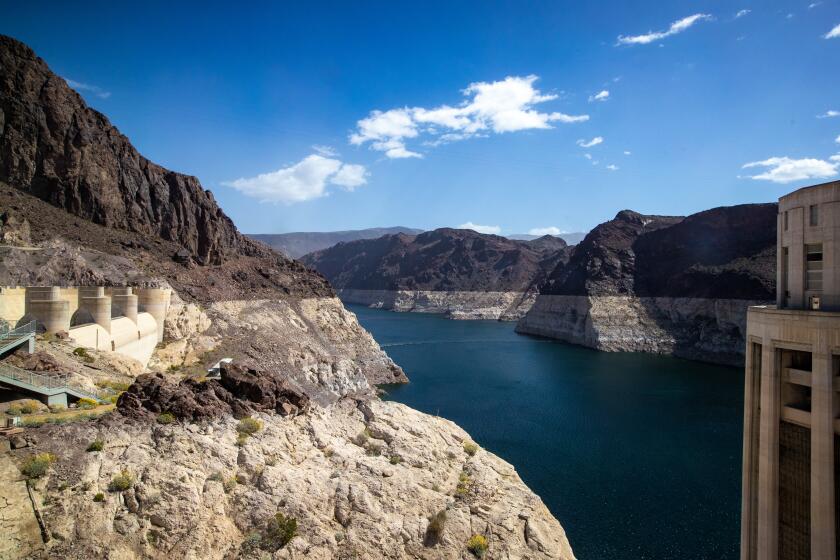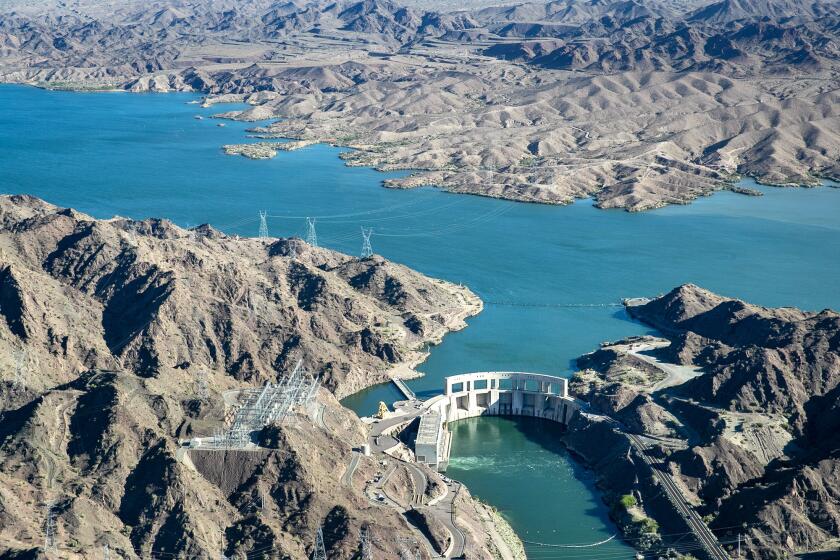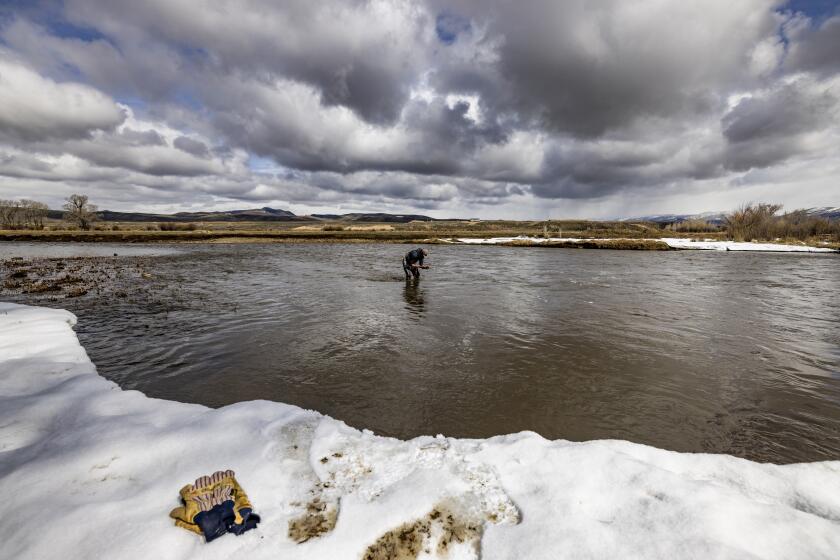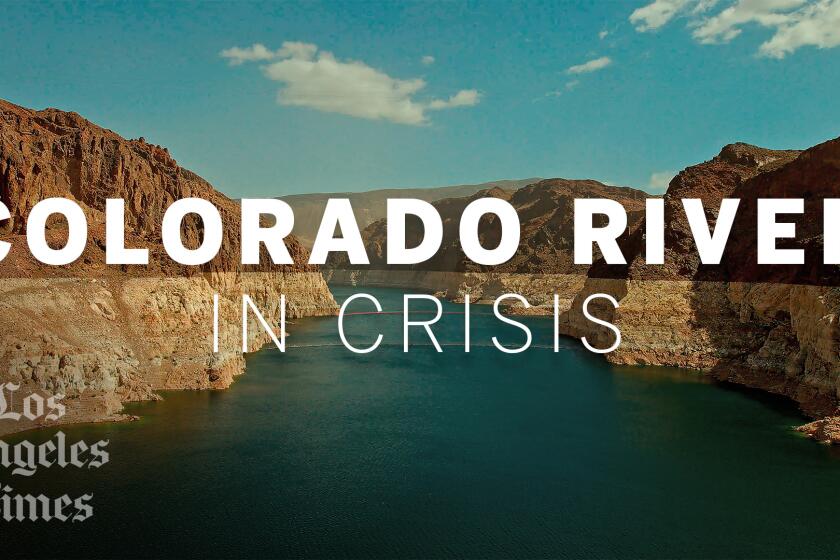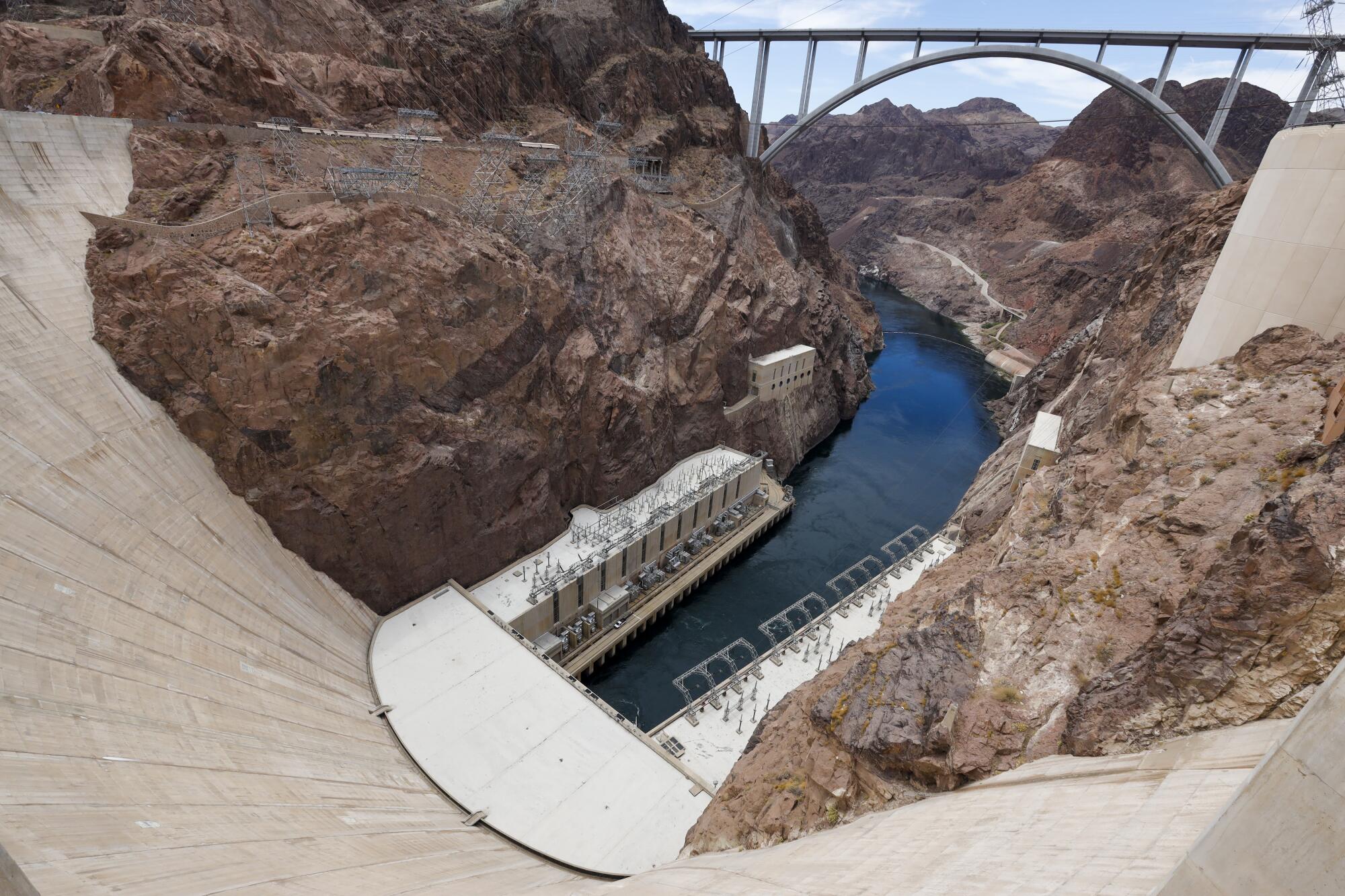
After a wet year and a push to conserve water in the Southwest, federal officials say the risk of the Colorado River’s reservoirs declining to critically low levels has substantially eased for the next couple of years.
The Biden administration’s top water and climate officials said the rise in reservoir levels and the ongoing conservation efforts will provide some breathing room for the region’s water managers to come up with new long-term rules to address the river’s chronic overallocation problem and the worsening effects of climate change.
“Even with the welcome rain and snow forecast across the West, the big picture remains the same. The past two decades have culminated in critically low reservoir conditions,” Reclamation Commissioner Camille Calimlim Touton said Tuesday.
“The prolonged drought crisis is driven by effects of climate change, including extreme heat and low precipitation,” Touton said. “The reality is that aridification will only intensify the drought-related impacts in the Colorado River Basin and the communities it supports. We know we must adapt to this new reality with innovative and durable solutions.”
She said the Biden administration, working with states, tribes and water agencies, has made progress in helping “protect the sustainability and stability of the Colorado River.”
Aggressive and impactful reporting on climate change, the environment, health and science.
The river’s flow has declined dramatically since 2000, and research has shown that global warming driven by the burning of fossil fuels worsened the long stretch of extremely dry years through 2022. Last year, however, storms blanketed the Rocky Mountains with an above-average snowpack, and this year the region’s snowfall and rain have been about average.
The water level in Lake Mead, the country’s largest reservoir , has risen nearly 29 feet over the past year, and the lake near Las Vegas is now at 37% of capacity.
Upstream on the Utah-Arizona border, Lake Powell, the nation’s second-largest reservoir, stands at 34% full.
Last year, California, Arizona and Nevada committed to reducing water use by 3 million acre-feet over three years, cutting usage by about 14% across the Southwest. Federal officials said those conservation efforts, largely supported by federal funds, are helping to boost reservoir levels.
The states proposed the short-term cuts to deal with water shortages through 2026, when the current rules for managing the river expire. The Bureau of Reclamation released its final analysis of the water reductions on Tuesday, saying the measures have substantially reduced the chance of hitting critically low reservoir levels for the next two years.
States that rely on the Colorado River agreed on a proposal for cutting water use. Officials say an analysis shows the approach addresses short-term risks.
Touton called it a significant milestone, saying the Biden administration has successfully “staved off the immediate possibility of the Colorado River system’s reservoirs … falling to critically low elevations that would threaten water delivery and power production.” She said the agreement on the short-term measures “has given us the breathing room to focus on the long term.”
The Bureau of Reclamation plans to complete a draft environmental review of long-term alternatives for post-2026 rules by the end of this year, and federal officials had asked representatives of seven states, tribes, water districts and others to present initial proposals by early March.
Negotiations among the region’s water managers, however, have run into disagreements and have led to competing proposals. Participants in the talks said there are disagreements between the three states in the river’s lower basin — California, Arizona and Nevada — and the upper basin states of Colorado, Wyoming, Utah and New Mexico, with the two camps offering separate proposals for reducing water use under the new rules.
The long-term rules, which will begin to take effect in 2027, will be developed “collaboratively, transparently and inclusively,” with input from states, tribes and other stakeholders, said Laura Daniel-Davis, the Interior Department’s acting deputy secretary.
“We are committed to pursuing a collaborative, consensus-based approach,” Daniel-Davis said. “We are not expecting every single issue to be smoothed out between the upper and lower basin tomorrow. But the reality is that everyone is saying the same thing: We are all committed to a basin-wide solution, and we’ll continue to work honestly and collaboratively through any major sticking points until consensus has been reached.”
California water agencies have signed new conservation agreements to help reduce strains on the overtapped Colorado River.
She said federal officials will continue to participate in discussions with stakeholders through the spring and summer “to achieve as much consensus as possible.” And as part of the talks, she said, the administration is ensuring that leaders of the 30 tribes in the Colorado River Basin “have a seat at the table.”
“Failure is not an option,” Daniel-Davis told reporters during a briefing. “As we envision what the next several decades of Colorado River management look like, the Interior Department is taking every possible measure to ensure that this vital system does not collapse.”
Much of the reduction in water use between now and 2026 is happening through deals that involve payments of federal funds. Agricultural landowners, water districts, tribes and cities are receiving payments as they reduce water use.
Federal officials said about three-fourths of the reductions in water use will be compensated through funds available from the Bipartisan Infrastructure Law and the Inflation Reduction Act. They said federal investments under 24 agreements to date total $670 million, with participants including the Imperial Irrigation District, the city of Phoenix and the Quechan Tribe, among others.
The Bureau of Reclamation’s officials said they are also in talks on additional conservation agreements to achieve the planned reductions through 2026.
“The Biden-Harris administration has been working to bring every tool and every resource to bear as we seek to both minimize the impacts of drought and develop a long-term plan to facilitate conservation and economic growth,” said Michael Brain, the Interior Department’s principal deputy assistant secretary for water and science.
The Colorado River is approaching a breaking point, its over-tapped reservoirs dropping. Years of drying have taken a toll at the river’s source in the Rockies.
The latest round of water-saving deals, which were announced Tuesday, include commitments of nearly 400,000 acre-feet of conserved water, with contributions coming from California’s Palo Verde Irrigation District, Coachella Valley Water District and Bard Water District.
The cuts in water use will help leave supplies in Lake Mead, boosting the reservoir’s levels.
White House National Climate Advisor Ali Zaidi said the Biden administration has moved quickly “in the face of a slow-moving disaster.”
“For the 40 million Americans across seven states that rely on this resource, climate change is not a question,” Zaidi said. “The question is, how do we come together? … How do we, in the face of this incredible crisis, come out stronger?”
Water experts and other observers have called for greater flexibility in the river’s management framework to adapt to extreme droughts and long-term drying driven by rising temperatures.
Some environmentalists have advocated more aggressive steps to plan for dwindling river flows, urging the government to consider draining Lake Powell and decommissioning Glen Canyon Dam to restore a free-flowing river upstream from the Grand Canyon — an idea that some influential California farmers have supported.
Responding to the federal government’s newly released review of the short-term conservation plan — called a final supplemental environmental impact statement — representatives of California, Arizona and Nevada said in a joint written statement that the plan “provides the stability we need to fully focus on long-term solutions.”
Journalists from the Los Angeles Times travel along the Colorado River to examine how the Southwest is grappling with the water crisis.
They noted that the three states’ combined water use last year was the lowest since 1983, which they said reflects a “collective recognition that the river’s health is the responsibility of everyone who relies on it.”
California uses more Colorado River water than any other state. But in 2023, deliveries of water from the river to the state were the lowest since 1949, said Adel Hagekhalil, general manager of the Metropolitan Water District of Southern California, which delivers water used by 19 million people.
He and others pointed out that a year ago, California was at odds with other states on conservation proposals, and there was talk that legal disputes might end up in court.
But since then, the three lower basin states “made a choice to sit down at the table and build realistic solutions that could quickly produce results,” Hagekhalil said.
“Cities and farms across the state are working hard to lower their Colorado River water use,” he said. “These efforts have helped stabilize the Colorado River for now, but we must all do more.”

